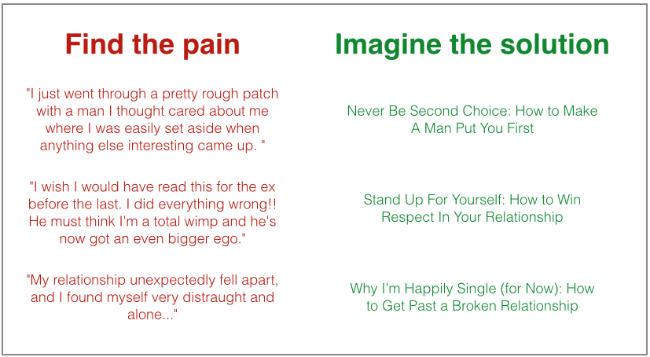Zippy Courses
Did you get here from a link from a friend? Make sure you sign up for this free training right here.
Welcome to Day 2 of "Creating Profitable Online Courses"
How to Find Your Online Course Idea In 15 Minutes (or Less)
Why do people buy online courses? The short answer is because they’ve got a problem – and they want to solve it.
Maybe they’re looking to learn how to use a complicated piece of software. Maybe they don’t fit into their favorite jeans and want to lose weight. Maybe they’re stressed out and overwhelmed and want to take control of their calendar.
Whatever the case: people buy online courses because they have a problem in their life and they want to solve it.
You see, most people make the mistake and think people actually want to spend their time learning new things.
But…
No one wakes up and screams, “The FIRST thing I’m going to do today is buy an online course. I LOVE LEARNING!”
Maybe you do. Maybe I do. But most people don’t. And those are the people you want buying your online course.
Now, the question is...
What should your first course be about?
Well…
Yesterday, in the PDF download (at the bottom of the page), I asked you to write three lists:
- Your skills
- What you help friends and colleagues with
- What you believe you can do
Now, to turn that list into a profitable online course, you want to find overlap between at least two of these lists.
And that’s where I’d start.
Here’s why:
Even though you don’t need a “degree” to sell online courses, you do need some semblance of credibility.
If you have the skill, or a history of helping friends, that’s credibility. You may not have a certification, but no one can argue with the results you’re able to produce.
And if you have a belief you can do it, that’s good too. Because maybe you’ll act just like Joseph Michael Nicoletti – and you’ll learn it as you go.
“What if I came up short on my lists?”
That’s no problem.
You can start with this next exercise.
Find the Pain – And Eliminate It
When you review that list, you’re likely already thinking about SOME courses you could make.
You may not know the specifics of that course yet. But you’re probably stewing with SOME ideas.
Now I want you to just pick one of them. Don’t pick it forever. Just pick it for now. And go through this little exercise I call “Find the pain – and eliminate it.”
I know this sounds morose, but bear with me.
Just because I’m asking you to find the pain right now doesn’t mean I want you to be negative in your marketing.
I just want you to understand your customer first… before you pick a course topic.
So, let’s do just that.
Let’s say on your list you picked the topic, “I want to help people with their relationships because my girl friends always ask me for advice.”
No problem!
Here’s what I want you to do…
Step 1: Find 3 or 4 best-selling books on the topic.
Step 2: Read the 5 star reviews and the 1 star reviews and look for “trigger phrases.”
A trigger phrase is an example of someone describing a problem in their life
A trigger phrase is also an example of someone bragging about a success in their life.
(If you’re confused, don’t worry. I’ve got an example).
Step 3: Start to compile a list of “Pain points” and “Solutions.”
That’s it.
Now let me show you this in action...
The topic is relationship advice for women.
When I searched that out on Amazon, I found 3 books. You could pick any books that have a decent number of reviews. I just happen to choose these 3 randomly…
“Ignore the guy, Get the guy”
“Why men love bitches”
“The soulmate experience”
Now, go through these books and
find the trigger phrases.
After going through the 5 star reviews of each book, I saw these examples of people describing problems in their life:
“I just went through a pretty rough patch with a man I thought cared about me where I was easily set aside when anything else interesting came up. ”
“I wish I would have read this for the ex before the last. I did everything wrong!! He must think I’m a total wimp and he’s now got an even bigger ego.”
“My relationship unexpectedly fell apart, and I found myself very distraught and alone…”
If you’re looking to help people with relationship problems, finding these problems helps you understand where your ideal customer is coming from. It helps you see the pain they’re going through so you can hopefully solve it.
That’s when you plot it on a little chart like this:

Now that you’ve found the pain people experience… your goal is to figure out what a potential solution might “look” like.
So, I want you to imagine a friend came to you with this exact problem. What would you tell them?
If a friend told you, “My man always sets me aside,” you’d tell your friend, “Well, don’t let him do that. Make him put you first.”
If a friend told you, “I’m distraught and I’m alone,” what would you say? “You just got out of a relationship. You should be single and happy about it!”
Right?
Do that for each pain. Just like this…

In reality, I’m just saying the opposite.
We’re taking someone’s pain, and turning it into a positive.
Now do you see how this is taking shape into a possible online course?
You start with pain. You know the solution. And that’s where your course comes in. You can help people go from pain to solution.
And bam.
You’ve got your first online course idea.
“What if I can’t find any books?”
That might be evidence that there isn’t demand for the type of online course you want to create.
But if you can’t find books, I’d also check for blog posts about the topic. If there’s a blog post and it looks like the blog posts are getting traffic, then you can do the same thing with blog posts.
Now Once You Have That Idea…
The next step is this: once you have an idea, you want to be sure you can actually sell this thing.
And that’s why I would spend time researching your competition. If you can’t find at least 10 people who are selling a course about what you want to sell a course about…
…then I’d probably find a new course.
(Note: If a course doesn’t exist yet, in a new, emerging popular market, it might be okay to go after it. As long as the pain is there. Because people will pay to alleviate that pain).
Anyway…
When thinking about your potential course, remember this:
#1 Best-Selling Online Courses
Promise A Specific Solution
If you want to succeed at selling online courses, you want to be INSANELY SPECIFIC.
Going back with the relationship example, notice how my solution never said something like “HAPPY RELATIONSHIPS WOO!”
Instead, I was talking to a SPECIFIC pain. And promised a solution on how to FIX that SPECIFIC pain.
You see, when most people start creating – and selling – online courses, they make general courses about things like branding, health, yoga, and other big terms.
The problem with that is that people won’t buy it. Sure, you might cover how to solve their problems inside the course, but remember, you’re asking people to pay you and if you want them to pay you right now, it’s best to talk to a specific pain with a specific solution.
Now The Question Is:
What Should I Include In This Course?”
I’ll cover that (and more) in tomorrow’s training material.
For now…
Here’s Your Chance To
Get My Advice On Creating Online Courses…
Still with me?
Good.
Now:
Here’s what I want you to do. In the comments below, I want you to write three things:
Pain: Describe the pain you want to talk to.
Solution: Describe what the solution looks like
My Course Idea: I want to create a course about…
And that’s it.
Then, I’ll do my best to provide feedback to everyone who leaves a comment today.
If you want to keep this confidential, feel free to email me your idea at news@socialtriggers.com